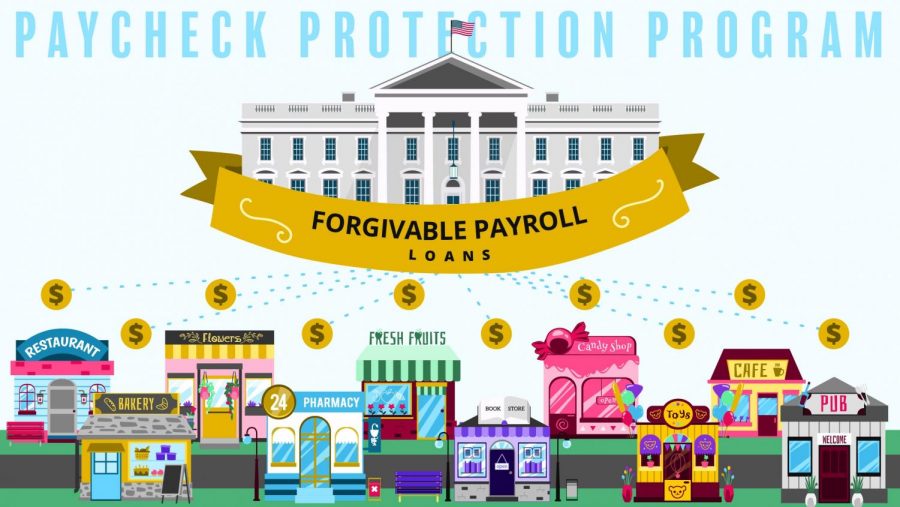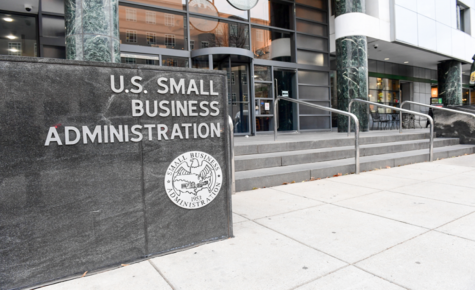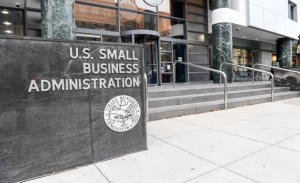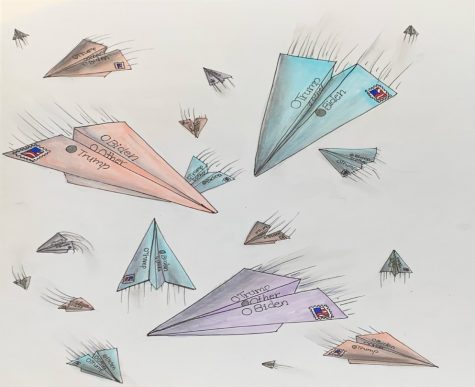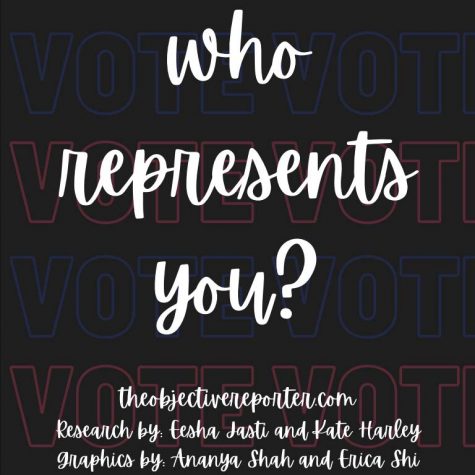Checks and Unbalance
May 13, 2020
An inside and holistic view of John Burroughs School’s decision to return their first ever federal loan.
In late March, with global economies feeling the crushing weight of the COVID-19 outbreak and collapsing in ways that had not been seen since the Recession of 2008, the United States Congress passed a $2.2 trillion stimulus package with hopes of revitalizing the economy and lifting some of the economic burden felt by millions of Americans who had been furloughed from work or had their businesses closed. That bill included $349 billion to create the Paycheck Protection Program (PPP), which was later increased to $660 billion. This program was designed to give forgivable loans to businesses that employed less than 500 workers in hopes of keeping them from falling into bankruptcy. While they may not have been the intended audience, thousands of independent schools across the nation saw a way to help their employees and applied for the loans as well. One of these was John Burroughs School, which applied for and received a $2.55 million loan from the Small Business Administration. “The school never voted on it,” explained Head of School Andy Abbott. “It just became very common knowledge in the school world that schools were eligible for these loans.” However, the universality of this belief would not hold for long. On May 5, after several New York Times articles and pleas from high government officials, The World revealed that Burroughs would, in fact, return the money. So what happened?
The Early Stages
The decision to apply for federal loans may have been unprecedented in school history, as Burroughs had never received federal funding in its almost one-century long existence, but it was certainly not a revolutionary idea among prep schools dealing with the uncertainty of the epidemic and the closures and economic downturn it had caused. “Most independent schools in the country applied for these loans,” claimed Abbott. This included, he confirmed, other St. Louis private schools, although he said he was unsure of “who got what.” Data provided by the National Association of Independent Schools (NAIS) backed up Abbott’s statement. This data, from the week of April 27, showed that 88% of private secondary schools nationwide had applied for or received the loans.This was corroborated by further data from INDEX member schools, a collection of independent schools across the country that have similar fundraising and test scores to Burroughs, which shows that 67% of these comparable secondary schools had applied for help from the PPP.
Any initial concerns that private schools may have had about accepting the loans were due to the fear that, by accepting money from the government, they would be obligated to take part in governmental education requirements, such as certain standardized testing. “There is always a question of whether an independent school should receive federal aid,” says Abbott. “The concern has always been if you accept federal aid does that make your school required to do things by the federal government?” However, after a close examination, in which the school found that there were no strings attached to the money, Abbott and the school’s Business Manager Laura Placio filled out the four-page application and submitted it to the Small Business Administration (SBA) on April 4. The request was approved and Burroughs received their money on April 15. “We felt like it was our responsibility to the employees and families at Burroughs to apply since this money was available to help businesses weather this situation,” Abbott says. His sentiment was echoed by Treasurer of the Board of Trustees Gonzalo Fernandez, who said that “our loan application was reviewed and approved… for the purpose of allowing us to meet our payroll and medical and retirement benefit needs for our staff during this time of crises [sic].” Although this rationale seemed uncontroversial at the time, some would begin to question it just several weeks later.
National Scrutiny
On April 29, New York Times reporters David McCabe and Ben Protess published a 1,500-word article which implied impropriety on the part of not just Burroughs, but other elite prep schools including Barron Trump’s school, St. Andrew’s Episcopal in Potomac, Maryland, and Sidwell Friends in D.C., whose alums include the daughters of former Presidents Barack Obama and Bill Clinton. The article criticized the schools, pointing out that “other schools, particularly some smaller and less endowed ones, are still struggling to get their applications reviewed.” Since thousands of independent schools took the money, Abbott believes that the reason JBS was included in the Times article was due to Shake Shack.

On April 20, New York restaurateur and Shake Shack founder Danny Meyer (‘76) announced that his company would be returning the $10 million loan that they had received from the PPP, becoming the first corporation to do so. After this announcement, Abbott says he was emailed by a reporter from the Times who wanted to know if Burroughs had taken money from the program. “I think he contacted me because we were the high school that Danny Meyer had attended,” said Abbott. While Meyer says he is not “remotely qualified” to comment on Burroughs’ decision to return their loan, he says that, in regards to his own company, that he is “proud that the quick decision set off a national debate, which has since led to well over $2B in loans being returned, and importantly, additional funding, further clarifications and improvements to the original PPP plan.”
Whatever the reason for Burroughs’ inclusion, this article would not be the reason that Burroughs returned the money. “[The article] was reporting on the fact that many schools, including John Burroughs, had relied on the language and direction of the Department of the Treasury to apply for and receive loans,” said Fernandez. “The article quoted many university heads from schools with significant endowments who stated that they believed that under the terms of the PPP program they were fully entitled to keep the loan funds.”

While McCabe and Protess may not have intended to pressure schools into returning their money, their reporting caught the eye–and ire–of Treasury Secretary Steven T. Mnuchin, who tweeted two days after the article was published that “it has come to our attention that some private schools with significant endowments have [taken the loans]. They should return them.” This criticism by a top Cabinet official was “surprising” to the Burroughs administration, and Abbott explained his confusion by saying “I don’t know of any time in history when people have been asked by the government to return money that has been awarded to them.”
Voices from Within
Criticism of the school’s decision was not limited to outsiders, however, and alumnus Charlie Dee (‘65) was quick to make his feelings known. Dee, formerly a union leader and professor at Milwaukee Area Technical College, said that, upon hearing that his alma mater had taken several million dollars from the Paycheck Protection Program, he was “aghast” and “shocked.” And he would share his displeasure with the school’s decision. In an email addressed as a “response to Andy Abbott that quickly made its way through alumni circles, Dee insinuated that by accepting the loan Burroughs was “displaying an unmitigated blindness to genuine hardship, to real poverty, to actual suffering that people thrown out of work and businesses forced to close are going through.” Dee, who is the older brother of current English teacher Michael Dee, continued to say that the program “was intended for people like my single-parent barber who has no family to fall back on, no child support, no savings.” At the end of his 700-word email, which was written before the school announced they would return their loan, Dee said that, in the future, he would send the money earmarked for his annual contribution to “more morally-grounded institutions.”
Dee insinuated that by accepting the loan Burroughs was “displaying an unmitigated blindness to genuine hardship, to real poverty, to actual suffering that people thrown out of work and businesses forced to close are going through.”
Despite the school giving the money back, he still says it is unlikely he will send Burroughs a check in the coming years. Explaining his rationale, he contends that “there are a lot of good causes and I see no reason to give to Burroughs if they could make such a huge mistake.” He explained that he fears taking the federal aid is a sign of the school returning to the way it was when he was a student, in the late 1950s and early 60s, when he says, most of the students and parents were “born on third base and thought they had hit a triple.”
In response to Charlie Dee’s email, Mr. Abbott said he found the alum’s opinions to be “unfair.” “I have 200 employees at Burroughs, most of whom make a very modest salary,” he said. “It is a fiduciary responsibility for an employer to take advantage of the opportunities that are presented and if you have the opportunity to take care of your employees, you have a responsibility to do so and [the loan] would’ve made an enormous difference to our situation.”
But Charlie Dee was not the only alum to share his disdain for the school after the Times report, with several of his classmates calling the administration “greedy” and “tone-deaf” in emails to the reporter.
“What really rankled me was that in Andy’s original letter [to the alumni] about accepting the money, [he] called it a ‘loan,’” wrote Kurt Lorenz (‘65), who called this characterization “disingenuous.” Lorenz was not the only one annoyed with the representation of the money as a loan. Dee explained his frustration with Abbott’s description and said that if the school really wanted a loan, they could walk into any bank and get one with great interest rates. “A number of them are probably run by Burroughs alumni,” he says.
Ginger Imster, Burroughs’ director of advancement and external affairs objected to that line of criticism. “There’s nothing else to call it,” she says. “It’s a loan… that’s what the SBA calls it.”
The controversy over the description comes from an additional part of the Paycheck Protection Program, which allows businesses to apply, once they have received the money, for loan forgiveness, which stipulates that money spent in the first two months will be forgiven. If they do not apply, the company will have to repay the loan with a 1% interest rate. Although the NAIS reported that 75% of secondary schools that received the loan asked for or planned to ask for forgiveness, Imster says that Burroughs was still discussing whether to take that additional step or not when they ultimately handed the money back.
Regardless, others in the Burroughs community continued to pile on. Responding to Dee’s letter on Facebook, Deborah Mefferd (‘65) wrote that “taking federal money designed to keep struggling business from ruin is unseemly… Named after an environmentalist and founded by suffragettes, Burroughs is due for some soul searching following this sorry incident.” In an email, she continued to say that “if Burroughs actually got into dire financial straights [sic], I’m sure the alumni would step up with donations to help.” While Dee and other members of the class of 1965 stressed that they treasured the education they received at the school, their views on Burroughs are perhaps best summarized from a sentence in Lorenz’s lengthy email, which reads “the greater issue [beyond the loans] is that there are isolated islands of wealth and privilege, private schools, second houses, private golf clubs, yacht clubs, elaborate debutante activities, private aircraft, but woe to the fool that suddenly grabs public funds intended for the little guy and then brags about it to the members.”
Not all alumni were so harsh in their comments, however. John Stamper (‘60) said that, despite disagreeing with the school’s initial taking of the loans, he found the decision to return the money “courageous.” When he originally heard that Burroughs had taken the money, Stamper says he was “surprised.” “I think there are a lot of desperate businesses and institutions who will not make it… and Burroughs is not in that position,” he says. However, unlike fellow alums, he praised the school for returning the loans. “If you think it was the wrong thing for them to take the money, you have to believe it was the right thing for them to change their mind and give it back… It is a courageous thing to say you were wrong,” he explains.
Returning the Money
On May 5, four days after Secretary Mnuchin’s tweet, The World reported that John Burroughs School would return all $2.55 million to the Small Business Administration, joining other top schools such as Middlesex School in Concord, Massachusetts, and Episcopal High School in Alexandria, Virginia, both of which were mentioned by the New York Times and lauded by Charlie Dee. In his email to Abbott, Dee quoted Episcopal headmaster Charles Stillwell’s statement about returning their loans. Stillwell said that his school “should not seek this kind of support when others need it more.”
 However, as Burroughs’ accounting firm RubinBrown points out in their May 8 newsletter, criticism of nonprofits’ (like Burroughs) decisions can come from either moral or legal angles. If Stillwell made the decision to return his school’s loan for moral reasons, Abbott chose the latter. “The Secretary [Mnuchin] asked us to return the loan, so we returned the loan,” Abbott said. “We were very grateful to receive the loan, we would have used the loan in the way in which it was intended, and then we were asked to return the loan, and then we returned the loan.”
However, as Burroughs’ accounting firm RubinBrown points out in their May 8 newsletter, criticism of nonprofits’ (like Burroughs) decisions can come from either moral or legal angles. If Stillwell made the decision to return his school’s loan for moral reasons, Abbott chose the latter. “The Secretary [Mnuchin] asked us to return the loan, so we returned the loan,” Abbott said. “We were very grateful to receive the loan, we would have used the loan in the way in which it was intended, and then we were asked to return the loan, and then we returned the loan.”
Because Middlesex and Episcopal had already returned their money when the Times ran their article, Burroughs became the first school mentioned in the piece to backtrack on its decision to keep the loan. Others, like the aforementioned Sidwell Friends and St. Andrew’s Episcopal, doubled down on their stances and (as of press time) are keeping the federal aid. “Each school… must base its decision to apply for and retain a PPP loan on its own facts and circumstances and the guidance provided by the Treasury Department and the Small Business Administration,” says lawyer Bill Bolster, who also serves on the Board of Trustees.
On May 6th, the day after Burroughs returned their money, the St. Louis Post-Dispatch mentioned the situation for the first time. In an article Imster decried for “misrepresenting” the school’s position, reporter Blythe Bernhard claimed the school returned the money amid “national backlash.” Imster pointed out that this article, nor any other published by the leading area newspaper discussed other St. Louis schools that took PPP loans. The report, she says, was “not a balanced nor a well-researched investigative piece… to say I was disappointed would be an understatement.” According to Ms. Bernhard, she contacted the Independent Schools of St. Louis in an attempt to learn about other area schools that took loans, but never heard back and “with a same-day deadline, I wasn’t able to dig deeper.” However, a week later, Bernhard broke the news that Mary Institute and St. Louis Country Day School had returned a loan of “undisclosed” value.
What happens next?
A school’s financial situation can change very quickly if one morning it wakes up down two and a half million dollars. Although Burroughs did not refund tuition, there are plenty of other places where they did lose money. The cancellation of Potpourri, Burr-Oak Camp, and parts of Bomber Sports Camp are just some of the sources of lost revenue. Another includes the endowment which, according to the school’s administration, had lost $9 million (of $55 million) as a result of the stock market’s downturn. Abbott also says that due to the economic conditions, there is an increase in financial aid requests, which the school hopes to meet. “We did as much financial planning as we could ahead of time,” says Abbott. However, he continued to say that “there will be a strain and we will try to cut costs in a way that will have the least possible impact on the student experience.” Fernandez added on by saying that “we don’t know what the future holds and the full impact of the crisis may not be felt for years. These are unprecedented times with a great deal of uncertainty.” The school is fully enrolled for next year and have not had any students, as of May 8, withdraw due to health concerns.
While this particular fight has been resolved quickly, it was nothing more than a proxy battle. The larger issue still remains: how should Burroughs, one of the best schools in the Midwest with wealthy donors and a large endowment, balance serving their student body and employees with aiding a St. Louis community that has been racially and socioeconomically segregated for decades? It is a problem the school has faced long before the coronavirus — and one that will persist long after the Paycheck Protection Program becomes a term able to be found only in the footnotes of a history textbook.
